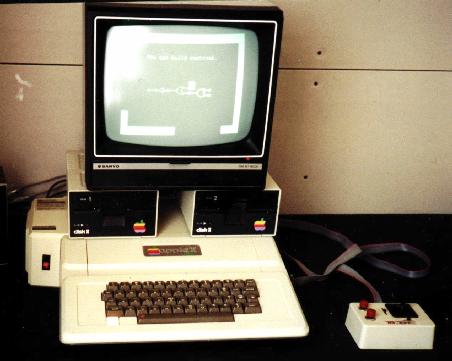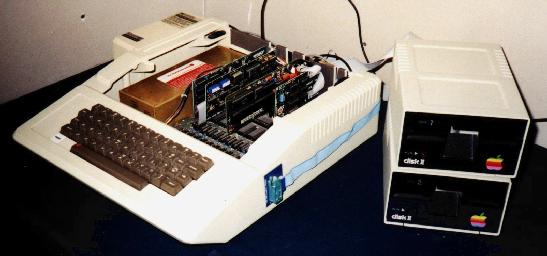Brendan's Classic Apple II Series Computers
Go to the Apple //c.
Go back to Brendan's Classic Computers page.
Apple ][+ (two-plus)
The Apple ][+ was my family's first "real" (meaning not a video game console)
computer.
I remember being intrigued when Dad first brought it home in the early 1980s
(1981, I think) when we were living in Huntsville, Alabama.
He got it with an extra 16k-bytes of RAM (up to 64k from the
48k default) and a Sanyo DM 5112CX "green-screen" monochrome monitor. It
also has an
M&R Enterprises SUP'R'MOD II, which is a UHF TV channel 33 output adapter
that I don't ever remember using, and an EnhanceWare "LCA-2" lower case
enhancement which replaced the original video character ROM.

On the outside of the case are a few more options that were added very
shortly after getting the machine. On the left, a Kensington Microware
System Saver is mounted over the cooling slots which pulls cool air
through the system while it's on. Doing double-duty, it also acts as
a surge supressor and power strip for the machine and an accessory such as
the monitor. On the right is a Versa Computing "EZ-Port" to place the
joystick/paddle port in a convenient location. For use with this port we
have two analog devices, a TG Products Joystick with trim adjustments and
2 buttons, and a pair of Apple ][ "Hand Controller" paddles (A2M0007).
Other accessories I have that are not shown here include:
- Apple Silentype Thermal Printer (A2M0036) with dedicated interface card, a
Synch Printer Interface Card
This little printer got lots of use with Magic Windows, the first word
processor I ever used. I typed up a paper in middle school (1986) about the
ancient egyptians and printed out numerous drafts on it. My mother used
it a fair amount, too, for various things. It uses thermal paper on a roll
and you simply tear it off when it finished printing. If it's more than
one page then it's time for scissors or a paper cutter! Because it simply
passes a dot-matrix heating element over the paper to make the "ink appear",
it's very quiet.
- Apple ImageWriter II with 32k RAM expansion
This was the first color dot-matrix printer I ever used. It uses tractor or
friction-fed paper and either a color or black ribbon. To get color out of
the color ribbon which has different stripes of the 3 primary colors and
black, it moves the ribbon up and down on the print head. Needless to
say, if it needs to mix colors, it has to make multiple passes across the
page for each line. What was really nice about the 32k RAM expansion was
that you could send an entire document (they were small in those days) over
the Super Serial card to the printer where it would be stored until it could
be printed. The computer itself could then go back to working with me, since
in those days, processors weren't fast enough and the operating systems
weren't powerful enough to do two tasks at once. This is the earliest form
of "background printing" that I can remember. The ImageWriter II printed
tons of color cards and signs courtesy of the Print Shop.
- Amdek Color I monitor
After going to a summer computer camp and using my first color monitor (which
also happened to be an Amdek Color I), I discovered what I had been missing
from the Apple ][+! I begged Dad to get one, and he finally did. (My folks
probably regretted sending me to that computer camp after that! They should
be happy I wasn't begging for Topo, a robot that I used at camp that could be
programmed through Logo, one of my favorite Apple languages!) Because the
monitor is simply NTSC composite, I currently have it hooked up to a VCR in
my bedroom for use as a TV.

The card slots in the picture above are populated as follows:
- Slot 0: Microsoft RamCard Memory Board - Language Card (Copyright 1980)
This is used for loading "Integer Basic", which wasn't the default Applesoft
Basic which was in ROM on the ][+. I believe it's also necessary for other
languages such as Pascal, which my high school was still using on Apple IIe
in 1992! Don't laugh too hard...after all, that was the way I finally
understood C pointers.
- Slot 1: Apple Super Serial Card (Copyright 1981)
This card provided the ][+ with a serial port at up to 9600 baud (Woo-hoo!)
for use with the ImageWriter series of printers or a modem, for instance.
- Slot 4: Sweet MicroSystems MockingBoard - Sound/Speech I (Copyright 1982)
This is the first sound card I ever used. At the time, my programming
knowledge wasn't great enough to actually do anything more than play games and
use the card as a speech synthesizer with the demo programs that came with it.
- Slot 6: Apple Disk ][ Interface Card - 16 Sector (Copyright 1978)
This is the little card that makes the pair of 5 and 1/4 inch full height
floppy drives
go! Without it and the drives, we would have been stuck using the built-in cassette interface.
Some of the software we have for the Apple II+ include:
- Broderbund's
- Apple Panic - One of the first games I had for the Apple II+, a classic reminiscent of Lode Runner.
- Print Shop - The original card/poster/banner publishing tool. This package got tons of use.
- Choplifter! - A great arcade game where you pilot a helicopter and save refugees.
- Spinnaker's
- FaceMaker - A younger kids' game, similar to Mr. Potato Head, but with animation.
- Alphabet Zoo - Another younger kids' game used to learn about the alphabet - lots of mazes.
- Story Machine - This was a great game where you could type out a story, and the characters you
create enact it like a play!
- Snooper Troops - Another really cool mystery game.
- Hayden Software's
- Sargon ][ - "The Computer Chess Program"
- Holt/CBS Software/SciSoft's
- T.rex - This was an awesome Tyrannosaurus Rex dinosaur simulation game.
- Infocom's
- Zork II - A classic text adventure game.
- Deadline
- Lightning Software's
- Master Type - "The Typing Instruction Game" - this game sure gave me a head start on learning how to type!
- The Learning Company's
- Rocky's Boots - This is probably one of the best educational games I've ever used. It played a role
in why I'm working for computer processor design companies now, yet I was playing it when I was only
8 or 9 years old. If you want to know what electrical engineers do when it comes to logic
design/computer chips, then this is a game for you! I feel that the follow-up to this is Robot
Odyssey (also by The Learning Company), which I have for my Tandy Color Computer 2. I've learned that it was actually available for the Apple ][ series and PCs as well as the Tandy Color Computer. Both are available as disk images at Ben Sokal's page or Thomas Foote's page.
- DLM's (Developmental Learning Materials)
- Arcademic Skill Builders in Math - Dragon Mix - A math tutor arcade game.
- C&H Video's
- The Menu ][ - A recipe-type database handler.
- Synergistic Software's
- Microbe - "The Anatomical Adventure" - This is an "Incredible Journey" (a.k.a. Issac Asimov) game
in which you're shrunk to microscopic size and injected into a sick patient. This is the only
game I have which makes use of the MockingBoard.
- Apple's
- DOS 3.3 Basics and System Master - Remember when the whole operating system could fit on one side
of a floppy and was centered around a programming language, such as BASIC? This Apple II+ is
the first computer I ever learned how to program on, and I owe much of my abilities today to
having learned how to program while young.
- LOGO - Logo saw almost as much use as BASIC. It's another programming language which is highly
procedural and graphics oriented.
- Scholastic Wizware's
- MicroZine - This was a subscription that my folks got me with periodic updates of various adventure
games, programming tutorials and languages, and more.
I also have a number of books that really got me going in programming:
- DataMost's Kids & the Apple - A combination of this book and my Dad are what really got me programming in
BASIC.
- Learning Logo - The manual that taught me Logo.
- Various Apple Manuals - I used all these for reference to DOS/BASIC/Logo, but they were too tough to learn
from for a 2nd or 3rd grader.
For more information, check out the following sites:
Go to my home page.
Go to the polylith.com home page.
brendan@polylith.com


